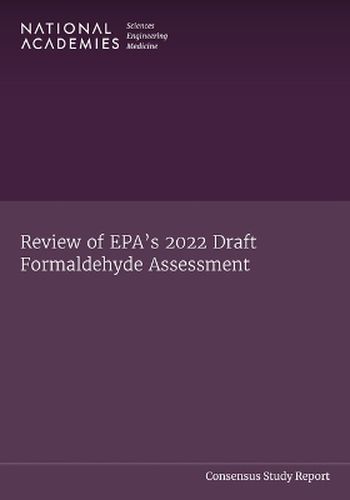Readings Newsletter
Become a Readings Member to make your shopping experience even easier.
Sign in or sign up for free!
You’re not far away from qualifying for FREE standard shipping within Australia
You’ve qualified for FREE standard shipping within Australia
The cart is loading…






Formaldehyde is widely present in the environment and is one of the highest production chemicals by volume, used in manufactured goods including wood products, permanent press fabrics, and household products. It is also formed by combustion sources and is present in smoke from cigarettes and other tobacco products, and in emissions from gas stoves and open fireplaces. In carrying out its mission to protect human health, the U.S. Environmental Protection Agency (EPA) identifies and characterizes the health hazards of chemicals found in the environment through its Integrated Risk Information System (IRIS) Program, which has reviewed the human health hazards resulting from formaldehyde exposure in several assessments.
This report is a continuation of guidance from the National Academies on draft IRIS assessments of formaldehyde and other aspects of the IRIS program. This report reviews the 2022 Draft Assessment with regard to its adequacy and transparency in evaluating the scientific literature, use of appropriate methods to synthesize the current state-of-the science, and presentations of conclusions that are supported by the scientific evidence. The report concludes that the 2022 Draft Assessment follows the advice of prior National Academies reports and that its findings on hazard and quantitative risk are supported by the evidence identified. However, revisions are needed to ensure that users can find and follow the methods used in each step of the assessment for each health outcome.
Table of Contents
Front Matter Summary 1 Introduction 2 Methods and Organization 3 Toxicokinetics 4 Noncancer Health Effects 5 Cancer Appendix A: Committee Member Biographical Sketches Appendix B: Public Session Agendas Appendix C: Case Study: Hanrahan et al. (1984), Human Sensory Irritation Appendix D: Point of Departure Analysis Using Two Studies: A Case Study Appendix E: Examples of Issues Identified by the Committee
$9.00 standard shipping within Australia
FREE standard shipping within Australia for orders over $100.00
Express & International shipping calculated at checkout
Formaldehyde is widely present in the environment and is one of the highest production chemicals by volume, used in manufactured goods including wood products, permanent press fabrics, and household products. It is also formed by combustion sources and is present in smoke from cigarettes and other tobacco products, and in emissions from gas stoves and open fireplaces. In carrying out its mission to protect human health, the U.S. Environmental Protection Agency (EPA) identifies and characterizes the health hazards of chemicals found in the environment through its Integrated Risk Information System (IRIS) Program, which has reviewed the human health hazards resulting from formaldehyde exposure in several assessments.
This report is a continuation of guidance from the National Academies on draft IRIS assessments of formaldehyde and other aspects of the IRIS program. This report reviews the 2022 Draft Assessment with regard to its adequacy and transparency in evaluating the scientific literature, use of appropriate methods to synthesize the current state-of-the science, and presentations of conclusions that are supported by the scientific evidence. The report concludes that the 2022 Draft Assessment follows the advice of prior National Academies reports and that its findings on hazard and quantitative risk are supported by the evidence identified. However, revisions are needed to ensure that users can find and follow the methods used in each step of the assessment for each health outcome.
Table of Contents
Front Matter Summary 1 Introduction 2 Methods and Organization 3 Toxicokinetics 4 Noncancer Health Effects 5 Cancer Appendix A: Committee Member Biographical Sketches Appendix B: Public Session Agendas Appendix C: Case Study: Hanrahan et al. (1984), Human Sensory Irritation Appendix D: Point of Departure Analysis Using Two Studies: A Case Study Appendix E: Examples of Issues Identified by the Committee